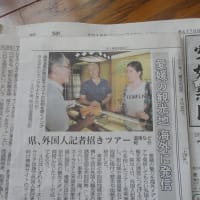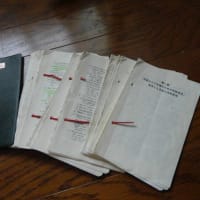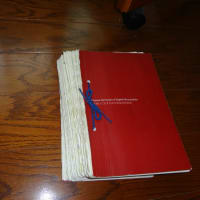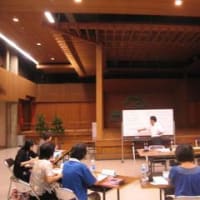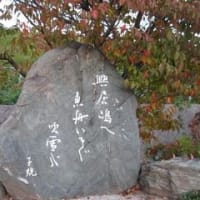(道後駅)
Nice to meet you, everybody. My name is Kazuo Itoh. I am a Japanese government-certified sightseeing guide and interpreter. I am very happy to have an opportunity to show you around this hot spring town.
We are now standing in front of Dogo Station. This railway service started in 1895. More than 100 years ago. Therefore, in those days ,the original station building was built. Later in 1911, just one hundred years ago, it was once rebuilt. And the present building was newly built in 1986, just 25 years ago. The original style and fashion is kept as much as possible.
(ぼっちゃん列車)
Look. This train is called Bochan Train. Bochan is the title of a novel written by a famous Japanese novelist Natsume Soseki. He lived in Matsuyama the service opening year, 1895. Taking the train,he often came to Dogo and enjoyed having a bath. The locomotive was imported from Germany in those days.
(時計台)
This is a gadget of clock. Every hour the clock opens out, and the characters from the novel Bochan are expected to make an appearance. This is a very popular device .
And this is Ashi-yu, or “foot bath.” Here people can enjoy hot spring waters without entering a bath house.
(本館前)
This is the main building of Dogo hot spring. This building was built in 1894.
And in 1994, or its centennial year, this was designated as a national cultural property. Recently, the Michelin Guide gave this building its highest rating of three stars. And also this is often cited as the model for an animated film of Spirited Away by Director Hayao Miyazaki.
Over there, on top of the roof, you can see a white heron. There is a legend that a white heron discovered this hot spring. This is one of the oldest hot springs in Japan. Since ancient times this hot spring has been favored by the Imperial Family members. Among them Prince Shotoku is the most famous. He was a person living around 600, serving as Regent for Empress Suiko. In 596 he visited here and was surprised by this hot spring’s excellence. After that, in the seventh century, two emperors came to this place. According to such historical events, we can say this region had been already well known across the nation, probably with both maritime and mountain products abundant.
(椿の湯前)
Look at this monument. Here is inscription of Prince Shotoku’s words. He visited this area in 596 and left his words of praise.
Prince Shotoku’s words are as follows:
The sun and moon shed light to people equally. Like that, coming from under the ground, this God-created hot spring gives all the people benefits equally. Bathing in this hot spring and getting recovered from a disease is like that a man fell in a pond with lotus flowers in the Paradise and an originally weak human could change to one who has attained enlightenment.
I can see a lot of camellia trees and flowers surrounding the springs and making a round space above, through which I can see the sky. And precious stone-like, red camellia flowers look very beautiful, with green leaves, glowing in the sunshine. And the buds and flowers are hanging down over the water. Under the camellias, I want to have a leisurely time.
I think Prince Shotoku gave a highest praise to Dogo hot spring. The camellia seems to have been abundant around here since old days. Today, the Matsuyama city’s symbol flower is camellia.
(子規記念博物館前)
Here we are at the square in front of Masaoka Shiki Memorial Museum.
Today we don’t enter this museum because time allowed is limited.
First of all, please look at this monument. Here is inscribed a tanka poem compose by Masaoka Shiki. This poem means:
“I cannot walk now, disease-curing Hot Spring in Iyo, there I could fly if I were a heron.”
Shiki was born in Matsuyama and a great master of haiku in the Meiji period. Also he made a great contribution to reviewing and enhancing a tanka literature in modern times. When he composed this tanka, he was bed-ridden in his Tokyo house due to his sickness. His nostalgia for the home town is expressed here.
Look at this monument. Here is inscribed two haiku : one is from Natsume Soseki and the other is Masaoka Shiki. Soseki’s haiku means:
Standing beside a fire bell, how tall the trees are, in winter season. This is a landscape of his house in his childhood in Tokyo, now the place around Waseda,in Shinjuku Ward.
Shiki’s haiku means:
Winter sweep, There is a reflection in a mirror , Of clouds in the sky.
This is composed when Shiki was in Matsuyama in 1895, which was his last home coming in his life time. At that time,he lived with Soseki in Matsuyama in the same house.
Soseki later became a great novelist, but at that time, he was an English teacher for Matsuyama Middle School. They had been close friends after they first met each other in Tokyo in the preparatory school for Imperial University.
Their communal life continued for some 50 days in Matsuyama. Every night Shiki hosted a haiku gathering and instructed people about haiku. Sometimes Soseki participated in it. Shiki died from a disease in seven years after that.
It is said that Shiki made a great contribution to establishing a modern Japanese prose style, which is more practical, efficient and realistic in depicting things in writing than the traditional styles before. There were several ways in writing those days. In other words, there was a kind of confusion. In terms of writing, or prose , Shiki advocated the concept of “Shasei.” It literally means a painter’s way of sketching a landscape. This concept was surely carried on to Sohseki. Their communal life in Matsuyama in 1895 was very short, but has a significant importance in Japanese modern literature.
(一茶の句碑前)
This is a haiku monument of Kobayashi Issa.
Kobayashi Issa was a renowned haiku poet living in the 18th century in the Edo period, who came to Dogo two times. In those days in Matsuyama lived a very famous haiku poet named Kurita Chodo. Kobayashi came here in order to meet with Kurita. This haiku was made at that time. It means:
As if a man were lying,A butterfly is resting there At Soto-yu .
There was a hot spa in the west of here called Soto-yu, or outer hot spa, where even a horse or cattle could drop their legs in the water for getting recovery from injuries. I guess that Kobayashi walked around there and he must have seen the scene of a butterfly resting on the rock or something around the waters. It is a very peaceful landscape. You often see many people are lying on the floor around the waters because it is very comfortable. I think the butterfly seemed to be a man lying comfortably on the floor to Kobayashi.
Since the days of the Edo period haiku has been very popular in Matsuyama. And it is no exaggeration to say that today Matsuyama is a Mecca of haiku in the world as well as in Japan.
赤字で記した部分は、従来の国際観光のやり方では、あまり着目されていない視点です。
Nice to meet you, everybody. My name is Kazuo Itoh. I am a Japanese government-certified sightseeing guide and interpreter. I am very happy to have an opportunity to show you around this hot spring town.
We are now standing in front of Dogo Station. This railway service started in 1895. More than 100 years ago. Therefore, in those days ,the original station building was built. Later in 1911, just one hundred years ago, it was once rebuilt. And the present building was newly built in 1986, just 25 years ago. The original style and fashion is kept as much as possible.
(ぼっちゃん列車)
Look. This train is called Bochan Train. Bochan is the title of a novel written by a famous Japanese novelist Natsume Soseki. He lived in Matsuyama the service opening year, 1895. Taking the train,he often came to Dogo and enjoyed having a bath. The locomotive was imported from Germany in those days.
(時計台)
This is a gadget of clock. Every hour the clock opens out, and the characters from the novel Bochan are expected to make an appearance. This is a very popular device .
And this is Ashi-yu, or “foot bath.” Here people can enjoy hot spring waters without entering a bath house.
(本館前)
This is the main building of Dogo hot spring. This building was built in 1894.
And in 1994, or its centennial year, this was designated as a national cultural property. Recently, the Michelin Guide gave this building its highest rating of three stars. And also this is often cited as the model for an animated film of Spirited Away by Director Hayao Miyazaki.
Over there, on top of the roof, you can see a white heron. There is a legend that a white heron discovered this hot spring. This is one of the oldest hot springs in Japan. Since ancient times this hot spring has been favored by the Imperial Family members. Among them Prince Shotoku is the most famous. He was a person living around 600, serving as Regent for Empress Suiko. In 596 he visited here and was surprised by this hot spring’s excellence. After that, in the seventh century, two emperors came to this place. According to such historical events, we can say this region had been already well known across the nation, probably with both maritime and mountain products abundant.
(椿の湯前)
Look at this monument. Here is inscription of Prince Shotoku’s words. He visited this area in 596 and left his words of praise.
Prince Shotoku’s words are as follows:
The sun and moon shed light to people equally. Like that, coming from under the ground, this God-created hot spring gives all the people benefits equally. Bathing in this hot spring and getting recovered from a disease is like that a man fell in a pond with lotus flowers in the Paradise and an originally weak human could change to one who has attained enlightenment.
I can see a lot of camellia trees and flowers surrounding the springs and making a round space above, through which I can see the sky. And precious stone-like, red camellia flowers look very beautiful, with green leaves, glowing in the sunshine. And the buds and flowers are hanging down over the water. Under the camellias, I want to have a leisurely time.
I think Prince Shotoku gave a highest praise to Dogo hot spring. The camellia seems to have been abundant around here since old days. Today, the Matsuyama city’s symbol flower is camellia.
(子規記念博物館前)
Here we are at the square in front of Masaoka Shiki Memorial Museum.
Today we don’t enter this museum because time allowed is limited.
First of all, please look at this monument. Here is inscribed a tanka poem compose by Masaoka Shiki. This poem means:
“I cannot walk now, disease-curing Hot Spring in Iyo, there I could fly if I were a heron.”
Shiki was born in Matsuyama and a great master of haiku in the Meiji period. Also he made a great contribution to reviewing and enhancing a tanka literature in modern times. When he composed this tanka, he was bed-ridden in his Tokyo house due to his sickness. His nostalgia for the home town is expressed here.
Look at this monument. Here is inscribed two haiku : one is from Natsume Soseki and the other is Masaoka Shiki. Soseki’s haiku means:
Standing beside a fire bell, how tall the trees are, in winter season. This is a landscape of his house in his childhood in Tokyo, now the place around Waseda,in Shinjuku Ward.
Shiki’s haiku means:
Winter sweep, There is a reflection in a mirror , Of clouds in the sky.
This is composed when Shiki was in Matsuyama in 1895, which was his last home coming in his life time. At that time,he lived with Soseki in Matsuyama in the same house.
Soseki later became a great novelist, but at that time, he was an English teacher for Matsuyama Middle School. They had been close friends after they first met each other in Tokyo in the preparatory school for Imperial University.
Their communal life continued for some 50 days in Matsuyama. Every night Shiki hosted a haiku gathering and instructed people about haiku. Sometimes Soseki participated in it. Shiki died from a disease in seven years after that.
It is said that Shiki made a great contribution to establishing a modern Japanese prose style, which is more practical, efficient and realistic in depicting things in writing than the traditional styles before. There were several ways in writing those days. In other words, there was a kind of confusion. In terms of writing, or prose , Shiki advocated the concept of “Shasei.” It literally means a painter’s way of sketching a landscape. This concept was surely carried on to Sohseki. Their communal life in Matsuyama in 1895 was very short, but has a significant importance in Japanese modern literature.
(一茶の句碑前)
This is a haiku monument of Kobayashi Issa.
Kobayashi Issa was a renowned haiku poet living in the 18th century in the Edo period, who came to Dogo two times. In those days in Matsuyama lived a very famous haiku poet named Kurita Chodo. Kobayashi came here in order to meet with Kurita. This haiku was made at that time. It means:
As if a man were lying,A butterfly is resting there At Soto-yu .
There was a hot spa in the west of here called Soto-yu, or outer hot spa, where even a horse or cattle could drop their legs in the water for getting recovery from injuries. I guess that Kobayashi walked around there and he must have seen the scene of a butterfly resting on the rock or something around the waters. It is a very peaceful landscape. You often see many people are lying on the floor around the waters because it is very comfortable. I think the butterfly seemed to be a man lying comfortably on the floor to Kobayashi.
Since the days of the Edo period haiku has been very popular in Matsuyama. And it is no exaggeration to say that today Matsuyama is a Mecca of haiku in the world as well as in Japan.
赤字で記した部分は、従来の国際観光のやり方では、あまり着目されていない視点です。











